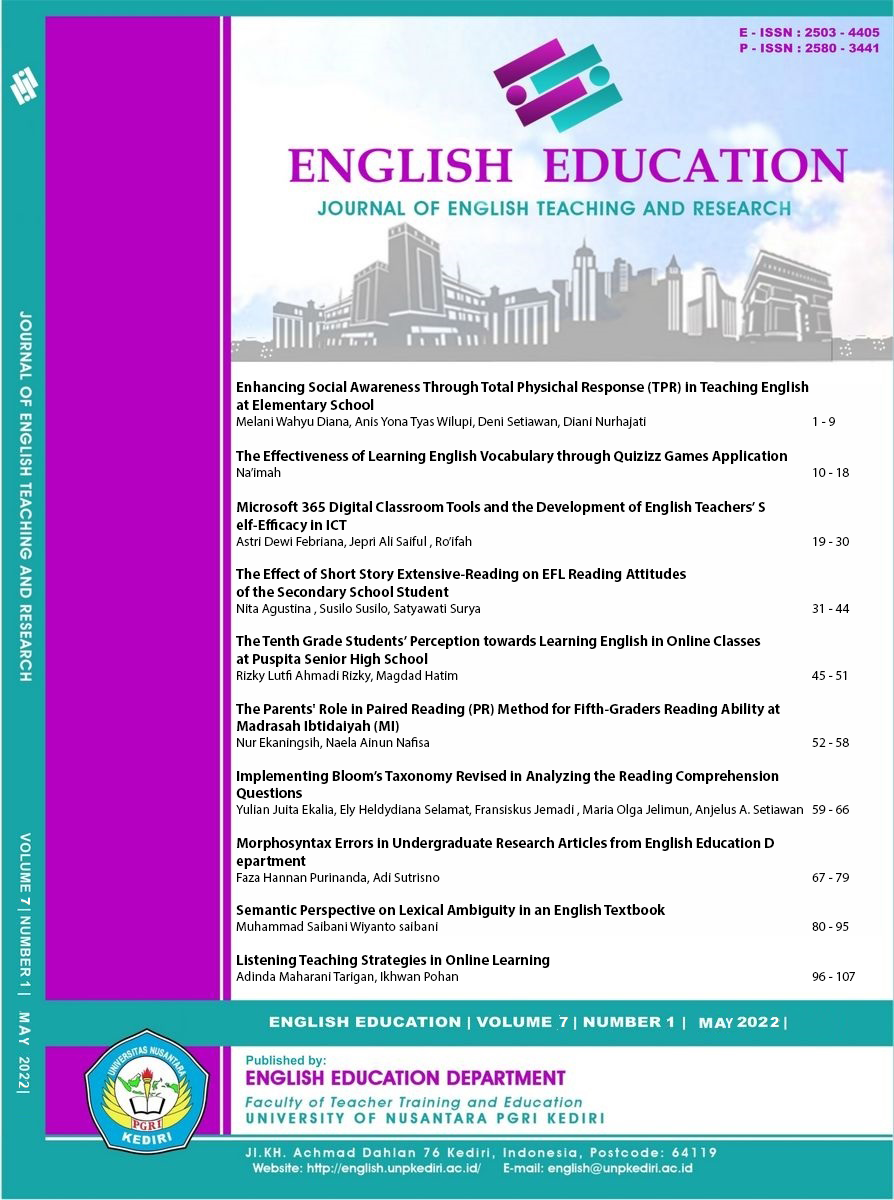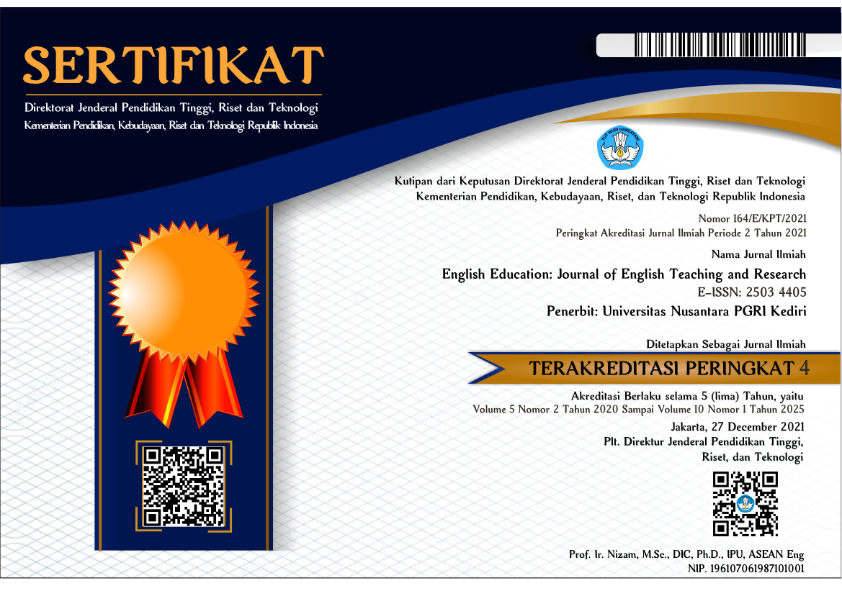Enhancing Social Awareness through Total Physical Response (TPR) in Teaching English at Elementary School
DOI:
https://doi.org/10.29407/jetar.v7i1.17460Keywords:
Social Awareness, TPR (Total Physical Response), English LearningAbstract
Teachers must equip students with several skills to face global competition in the 21st century. One of these skills is soft skills, one of which is social awareness. Ideally, teaching English to elementary school students should be child-friendly. Learning English in elementary schools trains students to communicate verbally using English in simple conversations and prepares students for social awareness. This study describes the stages in introducing Social Awareness through Total Physical Response (TPR) to teach English in Elementary Schools. This study used a qualitative approach, and the subjects of this study were the fourth grade, fifth, and sixth-grade students. The researchers collected the data by observing offline learning, interviews, and analyzing learning documents, such as textbooks, teaching media, etc. It was found that social awareness can be trained by selecting learning activities and suitable materials for young learners. The selected materials, such as daily activities, hobbies, and professions, give positive examples for the students. Learning activities such as working in-group groups/pairs and the material related to the current situation can improve students' social awareness, such as understanding the problem, empathy, and organization. It proves that TPR can be used to teach English and train the student's social awareness.
Keywords:Social Awareness, TPR (Total Physical Response), English Learning
Downloads
References
Adnyani, N. W. S. 2018. Metode Total Physical Response (TPR) Untuk Pengembangan Kemampuan Mendengarkan Dalam Pembelajaran Bahasa Inggris Bagi Anak Usia Dini. Journal Pratama Widya. 3(2).
Astutik, Y., & Aulina, C. N. (2018). Metode Total Physical Response (Tpr) Pada Pengajaran Bahasa Inggris Siswa Taman Kanak-Kanak. Jurnal Pendidikan Bahasa Dan Sastra, 17(2), 200. https://doi.org/10.17509/bs_jpbsp.v17i2.9658.
Cahyaningrum, E. S., Sudaryanti., dan Purwanto, N. A. 2017. Pengembangan Nilai-Nilai Karakter Anak Usia Dini Melalui Pembiasaan dan Keteladanan. Vol:6
Fauziati, E. 2014. Methods of Teaching English as a Foreign Language (TEFL): Traditional Method, Designer Method, Communicative Approach, Scientific Approach. Edisi ke-1. Era Pustaka Utama. Surakarta.
Goleman, D. (1998). Working with Emotional Intelligence - Daniel Goleman - Google Buku. https://books.google.co.id/books/about/Working_with_Emotional_Intelligence.html?id=ZNbsngEACAAJ&redir_esc=y
Gumiandari, S. (2021). Introducing English To Early Childhood Through Singing With the Total Physical Response Method. Acitya: Journal of Teaching and Education, 3(1), 86–94. https://doi.org/10.30650/ajte.v3i1.2138
Haryono, M. 2020. Meningkatkan Perkembangan Sosial Emosioal Anak Melalui Permainan Puzzle Angka Pada Anak Usia 4-5 Tahun Di Paud Gemilang Kota Bengkulu. JDER Journal of Dehansen Education Review. 1(1):5-11.
Miles, M. B. Huberman, A. M. dan Saldana, J. 2014. Qualitative Data Analysis a Methods Sourcebook. Edisi ke-3. SAGE Publications, Inc. Thousand Oaks, California.
Nuraeni, C. (2019). Using Total Physical Response (TPR) Method on Young Learners English Language Teaching. Metathesis: Journal of English Language, Literature, and Teaching, 3(1), 26. https://doi.org/10.31002/metathesis.v3i1.1223
Nurhajati, D. (2020). Pelatihan Pembelajaran Bahasa Inggris SD Ramah Anak. Jurnal ABDINUS: Jurnal Pengabdian Nusantara, 4(1), 119-130.
Suganda, L. A., Petrus, I., Zuraida, Z., & Kurniawan, D. (2018). A Study on the Creative Social Emotional Learning English (Csele) Classroom Model in Indonesian Context. Journal of English Literacy Education, 5(1), 34-41.
Ummah, S. S. (2017). The implementation of TPR (Total Physical Response) method in teaching English for early childhood. Advances in Social Science, Education and Humanities Research (ASSEHR), 58, 421-428. https://doi.org/10.2991/icece-16.2017.74
Wijayatiningsih, T. D., & Mulyadi, D. (2014). Pemanfaatan Model Total Physical Response Dan Repetition Untuk Pengembangan Pembelajaran Bahasa Inggris Anak Usia Dini/Tk. Jurnal Penelitian Pendidikan Unnes, 31(1), 125855. https://doi.org/10.15294/jpp.v31i1.5688
Zulpan, Z. (2018). Total Physical Response (TPR): Its Effect on Students’ Achievement in Reading Procedure Text. JEES (Journal of English Educators Society), 3(2), 205–214. https://doi.org/10.21070/jees.v3i2.1279
Downloads
Published
Issue
Section
License
Authors who publish with this journal agree to the following terms:
- Copyright on any article is retained by the author(s).
- The author grants the journal, the right of first publication with the work simultaneously licensed under a Creative Commons Attribution License that allows others to share the work with an acknowledgment of the work’s authorship and initial publication in this journal.
- Authors are able to enter into separate, additional contractual arrangements for the non-exclusive distribution of the journal’s published version of the work (e.g., post it to an institutional repository or publish it in a book), with an acknowledgment of its initial publication in this journal.
- Authors are permitted and encouraged to post their work online (e.g., in institutional repositories or on their website) prior to and during the submission process, as it can lead to productive exchanges, as well as earlier and greater citation of published work.
- The article and any associated published material is distributed under the Creative Commons Attribution-ShareAlike 4.0 International License








 Article template
Article template



